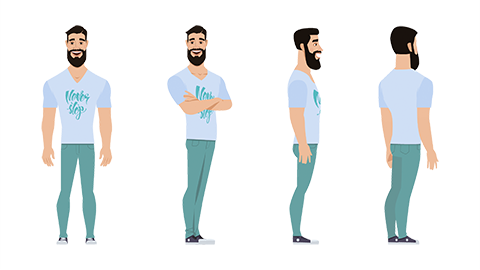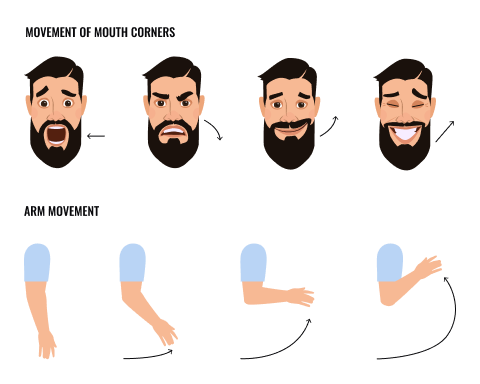Within the production pipeline, character animation is a specialised field.
Character animation is the process of bringing characters to life, whether they be human, animal, alien, robot or whatever your imagination creates.
There is a specific skill to character animation: 50% actor, 50% technician.
Why? Because as a character animator you are not only using the technical sides of software to bring a character to life. You are envisioning how they act, how they move, how they flow.
Force does not exist in animation. It is implied through posture, path of action, balance, timing, arcs, successive breaking of joints etc. It is implied by what the character does. Deciding why a character moves will reveal how it moves.
A key focus to character animation is motion.
Before we begin animating, we need to create our character. But how?

We begin with a process called character concept. This is where choose from a variety of tools to create our characters. These tools can include:
- Mind mapping
- Character profile
- Freewriting
- Power dump
- Random list
- Add on from a basic list
Think about how the characters personality, how are we going to make them feel. From here we can flesh out the ideas of how they look – their clothes, facial expressions, mannerisms.
This is an example of a character profile.
| Individuality | Detailed information |
|---|---|
| Flaws | |
| Graces | |
| Quirks | |
| Skills | |
| Cardinal sin (Pride, Greed, Envy, Wrath, Lust, Gluttony, Sloth) | |
| MBTI (Extroverted | introverted, Sensing | intuition, Thinking | feeling, Judging | perceiving) | |
| Look | Detailed information |
| Body | |
| Skin | |
| Hair | |
| Eyes | |
| Face | |
| Hands | |
| Unique features | |
| Movement | |
| Style | Detailed information |
| Colours | |
| Textures | |
| Tops | |
| Bottoms | |
| Accessories |
Once we have our character, we can draw them up. Depending on the type of animation you are using you may either build them with clay, draw them on paper or the computer.
Once we have our characters and the scene we can start to animate.

Scenario: Aqua World is a new animated adult adventure movie that is a mix of Atlantic/Blue planet/Aquaman and is underwater.
Develop character profile/s based on this new animation. This could be a hand drawing, online drawing or creation.
Remember all good stories can have a hero, villain, protagonist… what else?
The definition of motion as per Britannica is:
“Motion, in physics, change with time of the position or orientation of a body. Motion along a line or a curve is called translation. Motion that changes the orientation of a body is called rotation. In both cases, all points in the body have the same velocity (directed speed) and the same acceleration (time rate of change of velocity). The most general kind of motion combines both translation and rotation.”
Motion is what brings character animation to life.
A great tip to master motion is to record yourself performing different movements and actions. Then recreate with your animated character.
There are techniques to using motion that will bring key elements of our characters to life, they follow.
Timing and weight are a coupled pair. Why? Because to animate realistically there is a timing to the weight of the character. For example, if you had a little mouse, you would create quick movements. For a bigger character like an elephant, their movement would be slower and more of a thump. We want to believe that the character moved, not that someone moved the character.
To effectively show the weight of a character, pay attention to the ‘impact’. The impact shows how much effort it takes to stop the body weight from its downward motion, and the impact coming out describes how much effort is needed to raise the body weight.
Arcs are gestures or lines of action. Arcs are what give your animation consistency and flow.
If we think about anything in nature, nothing moves in mechanical- like line. Arcs increase the beauty and natural way things can move. They are gestures or lines of action.
Below are examples of arcs in character animation.

Follow through and overlapping is based on real-world physics.
Follow through:
- When a character or object stops suddenly, loose parts keep moving.
- Shows material properties of an object or character
- Required for animation to look realistic
- Can be exaggerated for a cartoony effect.
Overlapping action:
- Timing of different parts should be different
- Items down-chain from the main mass should move after the main mass
- When a character or object starts moving, loose parts drag behind
- Helps animation feel flowy and smooth instead of rigid or robotic
So, for example, follow through in animation would appear when a character with a scarf is running, when they come to a complete halt, the scarf will continue to flow in front of them and then fall back where the character has stopped.
Overlapping is like follow through as they are closely related to achieve the same goal of realistic motion.
Overlapping action is the idea that different parts of the body or character will move at different rates. So for example, if you had an animal character and made them run, their legs will be moving at a different speed to their head.
Both overlapping action and follow through are ways to provide convincing motion to animation.
Dynamic physics-based simulation is a way to automate this process.

